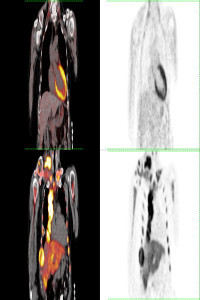Does PET-CT Contribute to Sitoreductive Surgery in Advanced Stage Colorectal Cancers?
Does PET-CT Contribute to Sitoreductive Surgery in Advanced Stage Colorectal Cancers?
Colorectal cancers are seen at a high rate in developed countries. The 5-year survival rate varies according to the stage of the disease at the time of diagnosis. Therefore, it is very important to detect the disease at an early stage, to stage it correctly and to determine the appropriate treatment options according to the stage. Surgical resection, neoadjuvant chemoradiotherapy and adjuvant chemotherapy are the treatment options according to the staging of the disease at the time of first diagnosis. Positron Emission Tomography-Computed Tomography (PET-CT) is used in the indications of diagnosis, staging, restaging, detection of recurrence and evaluation of treatment response in colorectal cancers. In this review, the limitations of current imaging methods and the place of PET-CT imaging in colorectal cancer staging and its potential future uses will be explained.
Keywords:
colorectal cancer, staging, positron emission tomography,
___
- 1. https://www.cancer.net/cancer-types/colorectal-cancer/statistics.
- 2. Ozis, S. E., Soydal, C., Akyol, C., Can, N., Kucuk, O. N., Yagcı, C., Erkek, A. B., & Kuzu, M. A. (2014). The role of 18F-fluorodeoxyglucose positron emission tomography/computed tomography in the primary staging of rectal cancer. World journal of surgical oncology, 12, 26. https://doi.org/10.1186/1477-7819-12-26
- 3. Petersen, R. K., Hess, S., Alavi, A., & Høilund-Carlsen, P. F. (2014). Clinical impact of FDG-PET/CT on colorectal cancer staging and treatment strategy. American journal of nuclear medicine and molecular imaging, 4(5), 471–482.
- 4. Llamas-Elvira, J. M., Rodríguez-Fernández, A., Gutiérrez-Sáinz, J., Gomez-Rio, M., Bellon-Guardia, M., Ramos-Font, C., Rebollo-Aguirre, A. C., Cabello-García, D., & Ferrón-Orihuela, A. (2007). Fluorine-18 fluorodeoxyglucose PET in the preoperative staging of colorectal cancer. European journal of nuclear medicine and molecular imaging, 34(6), 859–867. https://doi.org/10.1007/s00259-006-0274-4
- 5. Kijima, S., Sasaki, T., Nagata, K., Utano, K., Lefor, A. T., & Sugimoto, H. (2014). Preoperative evaluation of colorectal cancer using CT colonography, MRI, and PET/CT. World journal of gastroenterology, 20(45), 16964–16975. https://doi.org/10.3748/wjg.v20.i45.16964
- 6. Queiroz, M. A., Ortega, C. D., Ferreira, F. R., Nahas, S. C., Cerri, G. G., & Buchpiguel, C. A. (2021). Diagnostic accuracy of FDG-PET/MRI versus pelvic MRI and thoracic and abdominal CT for detecting synchronous distant metastases in rectal cancer patients. European journal of nuclear medicine and molecular imaging, 48(1), 186–195. https://doi.org/10.1007/s00259-020-04911-x
- 7. Tateishi, U., Maeda, T., Morimoto, T., Miyake, M., Arai, Y., & Kim, E. E. (2007). Non-enhanced CT versus contrast-enhanced CT in integrated PET/CT studies for nodal staging of rectal cancer. European journal of nuclear medicine and molecular imaging, 34(10), 1627–1634. https://doi.org/10.1007/s00259-007-0455-9
- 8. Bipat, S., Glas, A. S., Slors, F. J., Zwinderman, A. H., Bossuyt, P. M., & Stoker, J. (2004). Rectal cancer: local staging and assessment of lymph node involvement with endoluminal US, CT, and MR imaging--a meta-analysis. Radiology, 232(3), 773–783. https://doi.org/10.1148/radiol.2323031368
- 9. Kim, N. K., Kim, M. J., Yun, S. H., Sohn, S. K., & Min, J. S. (1999). Comparative study of transrectal ultrasonography, pelvic computerized tomography, and magnetic resonance imaging in preoperative staging of rectal cancer. Diseases of the colon and rectum, 42(6), 770–775. https://doi.org/10.1007/BF02236933
- 10. Park, I. J., Kim, H. C., Yu, C. S., Ryu, M. H., Chang, H. M., Kim, J. H., Ryu, J. S., Yeo, J. S., & Kim, J. C. (2006). Efficacy of PET/CT in the accurate evaluation of primary colorectal carcinoma. European journal of surgical oncology : the journal of the European Society of Surgical Oncology and the British Association of Surgical Oncology, 32(9), 941–947. https://doi.org/10.1016/j.ejso.2006.05.019
- 11. Mainenti, P. P., Iodice, D., Segreto, S., Storto, G., Magliulo, M., De Palma, G. D., Salvatore, M., & Pace, L. (2011). Colorectal cancer and 18FDG-PET/CT: what about adding the T to the N parameter in loco-regional staging?. World journal of gastroenterology, 17(11), 1427–1433. https://doi.org/10.3748/wjg.v17.i11.1427
- 12. Kwak, J. Y., Kim, J. S., Kim, H. J., Ha, H. K., Yu, C. S., & Kim, J. C. (2012). Diagnostic value of FDG-PET/CT for lymph node metastasis of colorectal cancer. World journal of surgery, 36(8), 1898–1905. https://doi.org/10.1007/s00268-012-1575-3
- 13. Bae, S. U., Won, K. S., Song, B. I., Jeong, W. K., Baek, S. K., & Kim, H. W. (2018). Accuracy of F-18 FDG PET/CT with optimal cut-offs of maximum standardized uptake value according to size for diagnosis of regional lymph node metastasis in patients with rectal cancer. Cancer imaging : the official publication of the International Cancer Imaging Society, 18(1), 32. https://doi.org/10.1186/s40644-018-0165-5
- 14. Culverwell, A. D., Chowdhury, F. U., & Scarsbrook, A. F. (2012). Optimizing the role of FDG PET-CT for potentially operable metastatic colorectal cancer. Abdominal imaging, 37(6), 1021–1031. https://doi.org/10.1007/s00261-012-9855-9
- 15. Yang, Q. M., Bando, E., Kawamura, T., Tsukiyama, G., Nemoto, M., Yonemura, Y., & Furukawa, H. (2006). The diagnostic value of PET-CT for peritoneal dissemination of abdominal malignancies. Gan to kagaku ryoho. Cancer & chemotherapy, 33(12), 1817–1821.
- Başlangıç: 2021
- Yayıncı: Mersin Üniversitesi
Sayıdaki Diğer Makaleler
Zehra Pınar KOÇ, Pelin Özcan KARA, Kadir ESER, Hamide SAYAR, İsa Burak GÜNEY
Does PET-CT Contribute to Sitoreductive Surgery in Advanced Stage Colorectal Cancers?
Pınar Pelin ÖZCAN, Gökçe YAVAN, Zehra Pınar KOÇ
Zehra Pınar KOÇ, Pınar Pelin ÖZCAN, Erdal DORUK, Yasemin YUYUCU KARABULUT
Pınar Pelin ÖZCAN, Zehra Pınar KOÇ, Mehmet ARSLAN, Gökçe YAVAN, Adil GÜMÜŞ
Additional SPECT/CT in Determination of Gastrointestinal Bleeding Site in Scintigraphy
Zehra Pınar KOÇ, Pınar Pelin ÖZCAN, Gökçe YAVAN, Zeynep Selcan SAĞLAM
